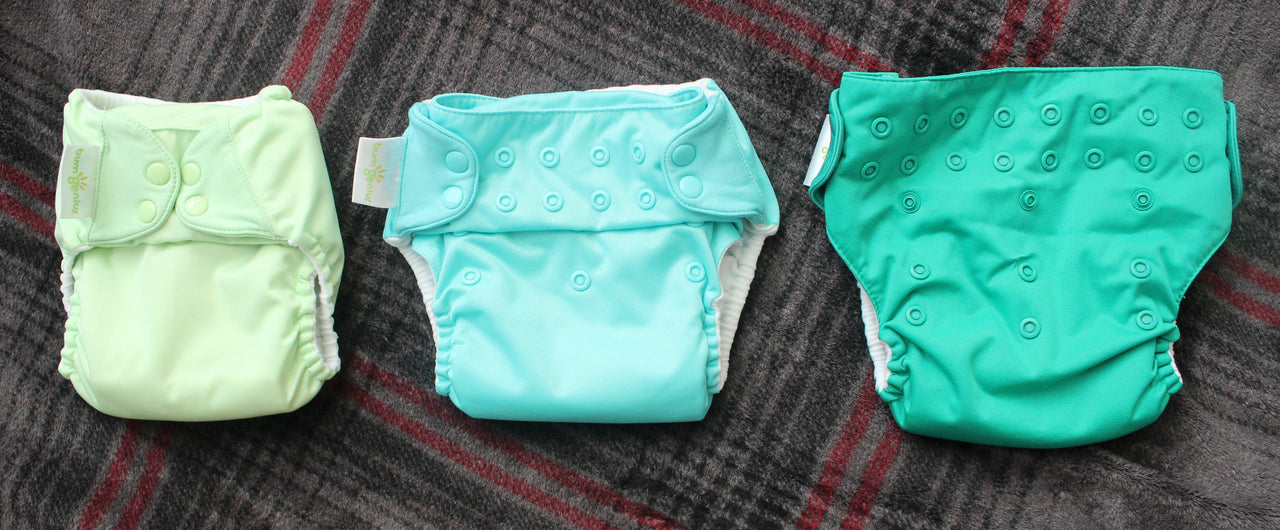
Upsizing One-Size Diapers
Erin Burt

One-size diapers usually offer several rows of snaps on the front of their diaper so that you can best customize fit for your child. A number of variables exist for when to size up and down. I’ve always just gone with my baby’s gut. As in, I take a look at my babe to assess when I change rise settings. A few things to consider when you assess your babe’s individual needs:
Each brand varies and fits each babe differently.
Most brands have three settings though a few have a third row of snaps allowing for a fourth, smaller size. Some brands have rows of snaps that may change the fit around the leg of babe when compared to brands with one row of snaps. Some brands are cut more trim or generous, both in their width and length (rise). If that was all gibberish to you, simply know that each brand is uniquely cut and so you may change the rise setting on one brand before you need to on another.
Consider weight.
Some brands have, specific suggestions based on weight or rise measurement (usually in inches), usually listed on their website within the diaper listing’s specs and sizing details. Every babe is built differently, but generality is helpful. The lowest rise setting usually is for a babe 8-15ish pounds. And medium rise setting(s) usually fit babes 15-25ish pounds. The largest rise setting (not snapped down at all) covers baby 25ish pounds and beyond. I use the “ish” because each brand varies as does each baby. I say to consider weight because if your baby weighs 14 pounds it is very unlikely (though possible) that you’d be on the largest setting.
 Other size matters.
Other size matters.
A tall slim baby and short plum baby can both weigh the same thing but the diaper fit very differently on the same settings. Height matters. Other particulars of a baby can make a difference in rise as well, like a babes particular bum size (large or flat, adequate or plump… whatever words you choose to use).
Make room for absorbency.
Diapers you use with increased absorbency (for night or naps) may require more space for the additional inserts. One easy way to get that extra space is by upsizing the snap setting.
Leaky baby?
If you are getting leaks around the legs you might be too tight (causing compression leaks) or too loose (allowing mess to leave the diaper before having the chance to absorb). You may need to size up (for compression) or down (for a diaper that’s loose).
Red lines.
Not unlike the red line on that pregnancy test you took months ago, red lines on the babe’s thighs let you know your babe is a growin’. While lines do not typically mean your baby is uncomfortable, a red line across the top of the thigh can mean the diaper is hitting low on him or her. Adjusting the rise to a larger size allows the diaper to sit higher on your baby’s body.
Gaping front.
If the diaper gapes open under the belly button in spite of your attempts to close the diaper snug, it may be time to size up.
After considering all of the above particulars, if you still aren’t sure try changing the rise on just a few of your diapers and see if the fit just seems better. Sometimes there is no clear answer as there are so many ways you can customize fit (rise, waist, and hip snaps). Generally you want to check that the waist and leg elastics are snug but not too tight, with the diaper sitting just under the belly button. If the fabric is droopy or excessive between the legs, you may be able to size down. The child shown in the diaper at each size setting could wear the diaper at two of the rise settings with success.
If you make it to the largest rise setting and your babe isn’t even walking yet, do not fear! Many babes “thin out” as they become more active. You may find you eventually need to size the rise down, though as a child gets taller the rise generally continues to grow longer.
(Side notes: Baby in photo is 6 months old, 18 pounds, and 28 ½ inches long. A few brands, like Fuzzibunz and Smart Bottoms utilize adjustable elastic to ensure the best fit on their one-size diaper options. Other brands put the snap size system in the interior of the diaper, like Bottom Bumpers that employs a snap method in the back interior.)
Lynette is a mom of three children from 6 months to age four. She has cloth diapered all three since birth and enjoys all things eco-friendly and mindful living.







